 I love capturing the world around me. I like feeling the energy and paying attention to the details as I move throughout my day. All to pour it into my sketchbook. Most of the time I am moving fast so I have trained my eyes to look as specific details when drawing people or places. When I do get a chance to slow down, I keep a small sketchbook and pen in my pocket to pull out while at bus stops or while waiting for a train. It’s in this practice that I can capture this essence. July with her long days allows you to capture the colors of the day up to the golden hour. One of my favorite things about painting or doing art outside is the conversations you have with passerbys. This is why public arts are so important. Public art offers another way to communicate without walls. Creating en plein air, a French term for outdoor painting, can be a wonderfully immersive and rewarding experience. Check out these tips to enhance your own en plein air painting sessions: 1. Plan Ahead: Choose your location carefully. Consider factors like lighting conditions, accessibility, and the subject matter you want to capture. Scout the location beforehand, if possible, to familiarize yourself with the surroundings. 2. Pack Light: Since you'll be outdoors, it's essential to travel light. Bring only the necessary art supplies to avoid carrying unnecessary weight. 3. Dress Appropriately: Be prepared for changing weather conditions. Dress in layers so you can adjust your clothing as needed. 4. Capture the Moment: Plein air painting is about capturing the essence of a scene in real time. Focus on capturing the mood, light, and atmosphere of the moment rather than getting bogged down in details. Be spontaneous and let the surroundings inspire your creativity. 5. Embrace Imperfection: Remember that plein air painting is not about creating a perfect replica of reality. 6. Take Breaks: Painting outdoors can be physically demanding, so be sure to take regular breaks to rest and recharge. Use this time to step back from your painting and assess your progress from a distance. 7. Have Fun: Enjoy the experience. Take pictures of your process and progress.
0 Comments
 Juneteenth marked the emancipation of enslaved Africans in the United States. As newly emancipated African Americans celebrated Juneteenth, our festivities embodied a blend of jubilation, resilience, and cultural reclamation. In the aftermath of emancipation, Juneteenth celebrations often commenced with religious services, acknowledging both the spiritual journey of their ancestors and the newfound freedom we had attained. Land was purchased and churches became focal points for community gatherings, where prayers, songs, and sermons reverberated with themes of liberation and hope. Central to Juneteenth festivities were communal gatherings, where families and communities came together to commemorate our shared heritage and collective struggle. These gatherings had vibrant music, spirited dance, and sumptuous feasts, creating an atmosphere of joy and unity. Juneteenth celebrations also served as occasions for education and reflection, as we as African Americans claim our history and assert our cultural identity. Orators delivered speeches highlighting the significance of emancipation and the ongoing struggle for equality. While elders imparted wisdom passed down through generations. Through storytelling, poetry, and artistic expression, participants honored the resilience of our ancestors and affirmed their commitment to justice and freedom. I can imagine all the things, food stuffs and effort it too for our ancestors to gather and make and embellish and make to annually celebrate this date. These objects serve to support in learning and understanding the user or purpose. As a Black artist I like to investigate how Juneteenth manifested into objects, food, art, fashion, and Black Economics. I want to support educators through project-based learning incorporating concepts and curriculums of Juneteenth and liberation all year round. Not just in June or February. Because Black people are Black all the other months of the year. If you didn’t know.  Elizabeth Catlett, Black Maternity, 1959 Elizabeth Catlett, Black Maternity, 1959 As a Black mother and an artist, I've come to realize that these two roles are not mutually exclusive, but rather beautifully intertwined in a dance of creativity, casual chaos and multiple varieties of nurturing. Balancing the demands of motherhood with the pursuit of artistic expression is a journey filled with challenges, but also immense rewards. Motherhood has a way of igniting a fierce creativity within. From the moment a child is born, a mother's world is transformed into a canvas waiting to be painted with love, patience, and boundless imagination. Yet amidst the chaos of parenthood, the artist persists, craving expression. Being a parent has not stopped my creative drive. During sleepless nights and endless chores, I steal moments to immerse myself in my craft, finding solace in the strokes of a paintbrush. I have a different intention around time, body and creativity as a[parent and this state is everchanging. There is always an adjustment. Being a mother has taught me the art of time management, seizing precious minutes, and turning them into moments of creative inspiration. At times, the demands of motherhood may seem at odds with the intersections between my personal artistic pursuits, society, and parenthood. Motherhood has expanded my artistic vision, infusing my work with a depth of emotion and empathy born from the experiences of nurturing and sacrifice. My child has become my greatest muse, inspiring me to see the world anew through their eyes and to continue to aspire for my own future as their mother simultaneously. And the simultaneous part is important to me. Being a mother and an artist is a delicate balancing act, requiring patience, resilience, and a willingness to embrace imperfection. As a Black mother, single parent, and someone with chronic pain; I have had to be even more aggressive with my creativity. This can be very difficult at times; especially when I literally must fight to be creative every day. I have also been able to stay true to the little girl inside me that wanted to be an artist and model that to my child. I have fostered a creative atmosphere for my child to be raised in where they can experiment with their own expressions to where we can create together. Advocating for artists who are also parents or caregivers is extremely important. I have learned that being a mother and an artist is not about achieving perfection, but about embracing the journey with an open heart and a curious mind. It is about finding inspiration in everyday moments and allowing creativity to flourish in all its ways. Shout out to all the art mamas! We out here! Keep up the great work! 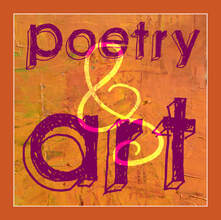 Poetry is a medium for self-expression, allowing individuals to articulate their innermost thoughts and feelings in a way that is both personal and universal. Through the careful arrangement of words, poets can convey complex emotions and ideas with clarity and precision, touching the hearts and minds of their audience. Whether it's the joy of love, the pain of loss, or the longing for meaning, poetry offers a means of connecting with others on a deeply human level. Throughout history, poets have used their craft to critique injustice, advocate for equality, and give voice to the marginalized. Poets have wielded their words as weapons against oppression and tyranny, sparking movements and shaping the course of history. Poetry can transcend linguistic barriers, offering a bridge between cultures and fostering empathy and understanding. Through translation, poems can travel across continents, carrying with them the richness of diverse cultures and perspectives. In a world fraught with division and conflict, poetry serves as a reminder of our shared humanity, transcending differences and bringing people together in a celebration of the human experience. This is why literature and poetry play a role in my visual art process. When I read Maya Angelou’s poetry or Sistah Sonia Sanchez poetry or Sista Soldiers Poetry or hear Gil Scott Heron poetry I stand at attention and grasp my role and my future. Some of my favorite lessons to teach art for people to interpret writing visually. One of my favorite things to do is to read and read my books and poetry books and envision an illustration to go with the writing. I do this with music lyrics too. When I read poetry, I can see images as I read them. All my senses are engaged. 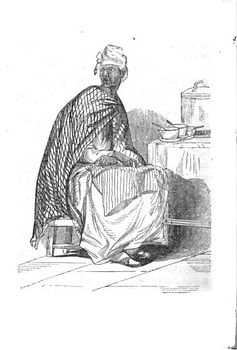 In the spirit of Equal Pay Day on March 13th, I wanted to highlight the lineage of Black women economics and entrepreneurship within the Philadelphia landscape. In the bustling streets of 19th century Philadelphia, amid the clamor of commerce and the echoes of societal upheaval, Black women emerged as unsung heroes of the city's economy. Despite facing systemic racism, gender discrimination, and economic hardship, these resilient individuals carved out spaces for themselves as street vendors, embodying entrepreneurship, and community strength. Philadelphia's vibrant street markets provided a stage for Black women to showcase their ingenuity and resourcefulness. Whether selling homemade goods, fresh produce, or homemade remedies, these women navigated the challenges of their time with unwavering determination. Often relegated to the margins of society, they transformed street corners into centers of economic activity and cultural exchange. For many Black women, street vending was not merely a means of survival but a form of resistance against oppressive structures. In a society that denied them access to formal employment and economic opportunities, entrepreneurship became a tool for autonomy and self-reliance. By seizing control of their economic destinies, these women challenged the status quo and paved the way for future generations. However, their journey was fraught with obstacles. Racial segregation and discriminatory laws restricted their mobility and limited their access to lucrative markets. Moreover, they faced harassment and violence from both law enforcement and white supremacists’ intent on maintaining the racial hierarchy. Despite these challenges, Black women persisted, finding solidarity and strength within their communities. They formed networks of mutual support, sharing resources and knowledge to overcome adversity. Through collective action and resilience, they asserted their right to participate in the economic life of the city and demanded recognition for their contributions. Today, the legacy of Black women street vendors in 19th century Philadelphia lives on, inspiring generations to come. Their stories remind us of the power of resilience, entrepreneurship, and community in the face of adversity. I celebrate their achievements through art and recognize the ongoing struggle for economic justice and equality. Their legacy continues to inspire me. 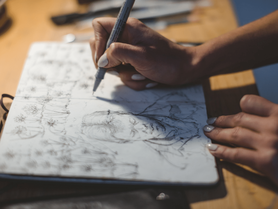 I love my sketchbooks so much! Maybe as much as I love my family, my child, or a good bowl of grits. Having a consistent sketchbook routine is so important and crucial to not only to me as an artist, but it is a necessary space for my rage, anger, joy, research, and observation. When I leave my house and observe the world around me, I can’t wait to get back home and put it into my sketchbook. When I am out, I can taste the inspiration that I get when I see something that interests me. I am also the type of person that carries little sketchbooks and pens with me in my purse. My purse is usually filled with mobile art supplies and Fenty. As an artist who also suffers from chronic pain I am consistently impaired physically. In the last 4 years I have been recovering from major surgeries that have kept me in a space of pain. I thought about Frida Kahlo and how she pushed through her pain during her recoveries while painting in bed. Well, that didn’t work. Painting can be so physical, and I just couldn’t make it work. Learning more Frida Kahlo, she had a bit more support than me to do her artwork from her bed. Instead, I poured my anguish into my sketchbook and committed to working on paper with drawing, collage, pastels and colored pencils and tempera sticks. I was able to snuggle with my sketchbook when I was tired or in a lot of pain. My sketchbook is a space that holds some of my purest forms of expressions. I don’t show people my sketchbook. To me it’s like showing my underwear. My sketchbook assists in rescuing my sanity and it helps me heal from the ills I face every day and it is a space where my mind and creativity can flow safely. I much rather go to my sketchbook, than curse someone out. Sometimes it doesn’t work. 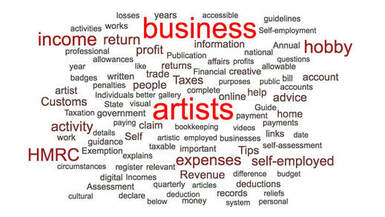 Being an artist is all about creativity, self-expression, and bringing your imagination to life. However, amidst the canvas strokes and musical notes, there's a less glamorous but equally important aspect to consider – taxes. While the thought of diving into the world of tax preparation might not be as exciting as creating art, it's a crucial step for us artists to ensure financial stability and compliance. Here are some informal insights on how artists can prepare for taxes without losing their artistic spirit. Check out these tips: -Keep track of income and expenses. We artists often have multiple income streams, from selling artworks to freelance gigs or performances. Try to establish a simple system to record all sources of income and related expenses. This not only helps in accurate tax reporting but also provides a clear overview of your financial health. -Consider setting up a separate business bank account. Mixing personal and business finances can lead to confusion during tax time. A dedicated account for your artistic endeavors streamlines financial management, making it easier to identify and categorize transactions for tax purposes. -Take advantage of deductions available to artists. Many expenses related to your art practice can be deducted, such as art supplies, studio rent, or even travel expenses for exhibitions. Keep receipts and documentation to support your deductions, ensuring you don't miss out on potential tax savings. -Embrace technology to simplify record-keeping. Numerous apps and software are designed to help artists manage their finances efficiently. -Consider consulting a tax professional specializing in creative industries. Tax laws can be complex, and having a professional on your side ensures you're taking full advantage of available deductions while staying in line with regulations. While taxes may not be the most thrilling aspect of an artist's journey, they are a necessary part of maintaining financial stability to be less stressed during tax time. Especially if you don't want to wind up eating your arts supplies at the end of the year.  STEM (Science, Technology, Engineering, and Mathematics) has long been championed as the cornerstone of preparing students for the future. However, an integral component often overlooked is the 'A' for Arts, transforming STEM into STEAM. The infusion of arts into K-12 education is not just about adding color to the curriculum; it's about cultivating creativity, critical thinking, and innovation. Incorporating the arts into STEM subjects offers a holistic approach to education. Creativity, nurtured through activities like drawing, music, and drama, enhances problem-solving skills and encourages students to think outside the box. In a world driven by technological advancements, the ability to innovate is paramount. By fostering creativity in the early stages of education, we empower future generations to become adaptable and resourceful thinkers. Consider the impact of visual arts in helping students comprehend intricate scientific processes or the use of music to teach mathematical patterns. Integrating arts into STEM subjects not only makes learning more expensive, but also ensures that students from diverse learning styles can grasp and retain information effectively. STEAM education fosters collaboration, mirroring real-world scenarios where professionals from various disciplines come together to solve complex problems. Team projects that incorporate both STEM and arts elements encourage students to appreciate the value of different perspectives and skill sets. This collaborative approach prepares them for the interdisciplinary nature of many contemporary careers. The arts contribute to the emotional and social development of students. Participation in creative activities boosts self-confidence, communication skills, and emotional intelligence. Students engaged in artistic endeavors learn to express themselves confidently, an invaluable skill that extends beyond the classroom. The Arts in STEAM education is not a mere embellishment but a catalyst for holistic development. It empowers students with a diverse skill set, fostering creativity, critical thinking, and collaboration. As we navigate an era of rapid technological evolution, embracing the arts is not just an option; it is a prerequisite for unlocking the full potential of our future leaders and innovators. The world is crazy. And if you are Black, well you know the rest. The past 10 months have been exhausting. From the Pandemic, injustices Black people, uprisings and incessant murders of Black men and women.
As a Black woman, visual artists, and mother I have always been on watch. I think about Black families and all the things we must go through to simply live, love and survive. Our children are our ancestor’s dreams! They are not meant to have their wings that were given at birth clipped short due to bigotry, injustice, and jealousy. I came across an image of a Black women who was marching in the riots that followed Brianna Taylor and George Floyd’s death. She was heavily pregnant holding up a sign that said, “We are not carrying for 9 months, laboring for 9 hours for you to kneel on their neck for 9 minutes. Black Lives Matter!” I truly felt that sentiment specifically as a Black woman and as a parent. Her statement was so loud to me and I uplift her and women and families who are parenting at this specific time. As an artist her image impacted me and inspired me to make this piece. Another element to the image was that I am her. I relate to her because the fact that she must hold up a sign to prove her point. to prove her humanity is something Black people, Black people and other People of Color must battle with every day. I have this battle with my job, at school, and every time I step outside my house. I am a Black woman and mother! I am here! This Black North Philly Woman is here! We are still here! Black women and Black mothers are always at the frontline the revolution because we birth, the future. We birth revolutions. We gon' stay free my looking to our reflections for the answer! We are the answers we are looking for! 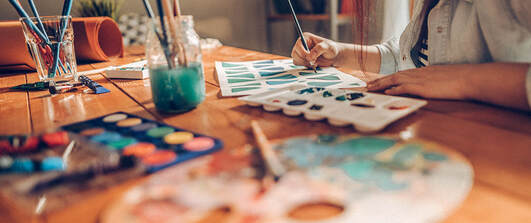 In a world that often emphasizes traditional paths, fostering the creative spirit of our youth is more important than ever. Whether your child is passionate about painting, dancing, writing, or any other form of art, providing support and encouragement can make a world of difference in their artistic journey. It can be crucial to listen and understand your young artist's aspirations. Engage in open conversations about their passions, interests, and dreams. Create a space where they feel comfortable expressing themselves without fear of judgment. By actively listening, you not only show your support but also help them gain confidence in their creative endeavors. Encourage exploration by exposing your child to various art forms. Attending local art events, visit museums, and explore different artistic communities together. This exposure can broaden their perspectives, inspire new ideas, and help them discover their unique artistic voice. Provide the necessary tools and resources to fuel their creativity. Whether it's investing in quality art supplies, enrolling them in workshops, or creating a designated art space at home, these gestures convey the message that you believe in their talent and are willing to invest in their artistic growth. Celebrate their achievements, no matter how small. Display their artwork proudly, attend their performances, and share their creations with friends and family. Positive reinforcement boosts youths self-esteem and motivates them to continue pursuing their artistic passions. Supporting your artistic youth also involves respecting their artistic process. Avoid imposing your expectations on their creative expression. Instead, encourage them to experiment, make mistakes, and learn from the artistic journey. Embracing the uniqueness of their artistic voice fosters a sense of independence and confidence. Connect them with mentors and artistic communities. Networking with experienced artists and like-minded peers can provide valuable guidance, inspiration, and a sense of belonging. Attend workshops, join art clubs, and seek out mentors who can offer insights based on their own artistic journeys. As a Black artist, who was a youth; no one in my family was an “artist”, however they observed my budding skills and supported me with materials. This can be difficult especially for marginalized communities due to systems that mystify creativity and artistic lifestyles. Being an “artist” or “creative” feels unattainable. Supporting your artistic youth is about creating an environment that nurtures creativity, fosters confidence, and celebrates individual expression. By doing so, you empower the next generation of artists to embrace their talents and contribute to a more vibrant and imaginative world. Shout out to all the parents and guardian supporting their creative youth. I got a lot of paint stains, ink blots and clay on the rug in my youth. |
Author
|
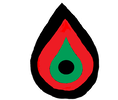
 RSS Feed
RSS Feed